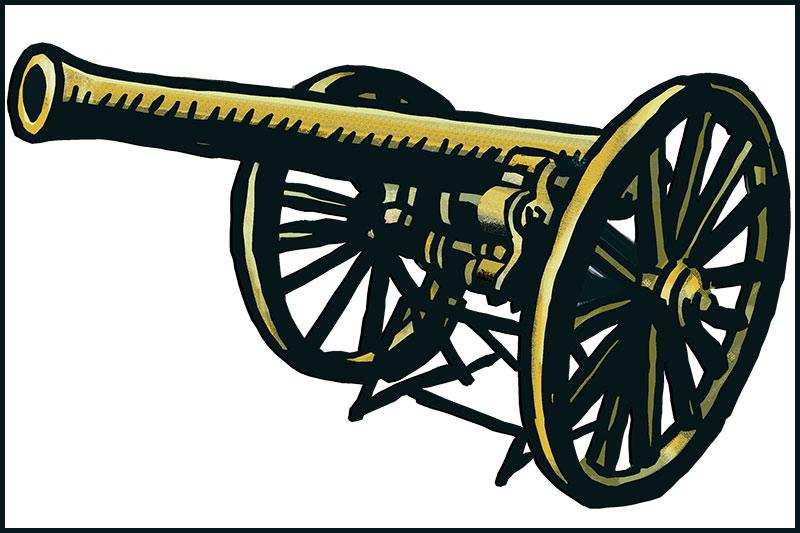Big guns
This is a cannon city.
Cannons to the left of us, cannons to the right of us, cannons in front of us, with apologies to Lord Tennyson’s “Charge of the Light Brigade” and an immediate disclaimer that left and right have nothing to do with politics.
At the Cabildo across from Jackson Square is a 3-ton, 10 ½-foot long Spanish cannon from the Battle of New Orleans in 1815 that may have been manned by Lafitte’s Baratarians, the rogue warriors of the pirates Jean and Pierre Lafitte. History tells us the Baratarians manned two 24-pound cannons and a 32-pounder during the battle with the British.
At the Chalmette Battlefield, where the Battle of New Orleans was fought on Jan. 8, each year there is a re-enactment with many working cannons fired to commemorate the occasion. Singer Johnny Horton’s famous song about the battle says: “We fired our cannon till the barrel melted down/ So we grabbed an alligator and we fought another round/ We filled his head with cannonballs ‘n’ powdered his behind/ And when we touched the powder off, the gator lost his mind.”
Across Jackson Square stands Washington Artillery Park at the Moonwalk, which features a Civil War cannon that pays tribute to the 141st Field Artillery of the Louisiana National Guard.
Head toward Esplanade Avenue on Decatur Street and you find the gilded statue of Joan of Arc, the Maid of Orleans, the hero who led the Siege of Orléans in France against British forces in the 1420s, where cannons were used extensively. Donated by France to New Orleans in 1972, at her statue are two cannons.
On Tulane’s campus in front of the Navy ROTC building at Freret Street and McAlister Drive is a naval cannon made in 1911, which has been there seemingly forever—at least since 1941, maybe earlier.
Once displayed at Bart’s Lighthouse Inn on the New Basin Canal at the Lakefront, the old Coast Guard rescue cannon from the 1920s was bought privately. It was placed on treacherous reefs near the lighthouse to fire a rope across a foundering ship and rescue those on board. Refurbished and capable of firing, it is now located at the private Lakeshore Club.
And don’t forget the “Cajun Cannon,” former New Orleans Saints quarterback Bobby Hebert, now sports talk host for WWL-AM 870 radio.
It’s no secret why there are so many cannons and stories to go with them. This is an old city, founded in 1718 and involved in protecting its residents, and fighting skirmishes, battles and wars throughout its history.
Perhaps the most famous local cannon story involved not any military, but a Super Bowl. In 1970, at Tulane Stadium on Willow Street, the Kansas City Chiefs defeated the Minnesota Vikings. At halftime, the Battle of New Orleans was re-enacted. A cannon misfired, unfortunately striking a man’s hand. The combustion sound caused the horse carrying the man playing Gen. Andrew Jackson to bolt, according to one report, thus rewriting history with the British winning. Adding insult to injury, the man with the bloodied hand was almost run over by a runaway ostrich pulling a chariot. No explanation why an ostrich or a chariot would be involved was made, except that the show was produced by a former entertainment director at Disneyland.
The newest cannon on the scene is not new, nor does it have anything to do with the city’s history. In a residential neighborhood on Nashville Avenue near Tchoupitoulas, passers-by have been gawking at what turns out to be a 3-ton siege cannon made at a foundry in Liege, Belgium, circa 1820. A formidable weapon, it fired a 30-pound cannonball from a 6.25-inch bore and had a range of 2,900 yards. With its new carriage, it weighs 9,500 pounds.
Thieves won’t grab this big boy and put it in the back of a pickup truck.
Tastefully displayed and restored, there is a plaque showing that the cannon is named “Miss Tini,” after 8-year-old Christina “Tini” Alequin, a third-grader at Lafayette Academy Charter School. Cannon owner Patrick J. Sanders said, “She inspires me because she is always so happy.”
Sanders, 54, a local attorney, answered the obvious question with, “Doesn’t every man want one? Growing up, going to Fort Pike, the Chalmette Battlefield, I was drawn to cannons,” he said. When he finally had enough disposable income to fulfill his dream, he started looking around, and in March 2015, he bought it at a cannon auction in Maine.
Originally found on the site of a French seacoast fort, the cannon likely had been used for defense. The logistics of collecting it in Virginia and getting this beast to New Orleans were challenging. “Every bit of heavy equipment we used was maxed out,” said Frank “Peanut” Lensmyer III, Sanders’ lifelong friend and cohort in this venture. Lensmyer, a Tulane electrical engineering student in the ’70s, said he and Sanders “watched videos to see how we could shoot it without killing ourselves.”
The barrel and fuse hole were cleaned and the cannon restored to operating condition at L&L Marine in Harvey, Louisiana, then transported to Lafitte, where it was test fired. “It was loud,” said Lensmyer, despite that only one-third (5 pounds) of the normal load of black powder was used. The barrel was then plugged and silicone put in the fuse hole for safety purposes.
“Don’t tell us no, you can’t do it,” said Sanders. “Say that to Peanut and me, and it gets done.”
BOOM!
A 1966 graduate of Tulane, Angus Lind spent more than three decades as a columnist for The Times-Picayune.

